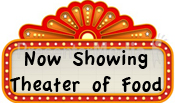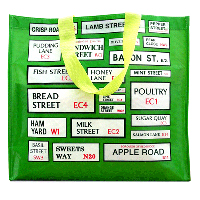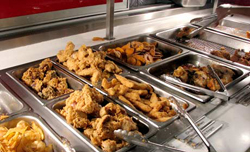Archive
The Theater of Food, Not Yet in 3D – Background and Questions

No blog readers this post is not a review of some avant-garde film that will be shown at the Sundance Film Festival. Rather this is an attempt on my part to bring the various interpretations of this relevant, yet overly hyped, retail food industry buzzword more clearly into focus while also suggesting what it really should mean to shoppers and retailers alike. No Kevin this is not a an attempt to steal yours or Michael’s thunder – for the non-industry reader see further below on this post on what I meant by this when I reference these industry observers, it is to look closer at the attempts to make food shopping more entertaining,
First though let’s define exactly what are the most important aspects of food shopping from the standpoint of today’s consumer and later we will delve into just what the retail food industry defines as the necessary components for their implementation of the Theater of Food marketing concept.

From the mainstream consumers standpoint the first requirement in food shopping is to purchase products that are compatible with their taste and dietary needs and if applicable those of their family, spouses or significant others. The second food shopping requirement, especially in today’s economy, is ability to purchase their food products at a reasonable net price. Now there are a few additional, yet mostly unspoken food shopping requirements, that most consumers have such as the cleanliness of the store that they shop at because after all it is where they are purchasing the food that they and possibly their families will consume – see my post on Nat Geo. Finally today’s mainstream food shopper is also interested in convenience, selection along with a reasonable level of customer service.
If you noticed that in the previous paragraph we used the term “mainstream consumer’s” standpoint to define a particular group of food shoppers. We then identified their requirements as it pertains their choice of retail supermarkets that they will patronize.
 Please note that we will now be introducing a different group of food shoppers to this post and they are commonly referred to as the “Foodie”. The Foodie group of shoppers have additional food shopping requirements along with the previously noted ones of the American mainstream food shopper.
Please note that we will now be introducing a different group of food shoppers to this post and they are commonly referred to as the “Foodie”. The Foodie group of shoppers have additional food shopping requirements along with the previously noted ones of the American mainstream food shopper.
It is my position that the Foodie group of shoppers prepare a more eclectic non-traditional type of meal on a regular or semi-regular basis. Perhaps the Foodie group of shoppers are Food Channel viewers or even subscribe to some of the recipe-cooking websites and blogs. The Foodie shopper might also prepare their meals in a HGTV style kitchen or at least equip theirs in a Williams and Sonoma kind of way. While this might seem like a sweeping generalization to some it certainly does define, for the purposes of this post, the Foodie as a type of shopper who has more than a passing interest in food. It should also be noted that a Foodie can also be someone who shops at a store with a significant selection of already prepared foods. This way the “Pseudo Foodie” can eat from a varied menu yet have someone else do the prep work for them – the store. More on this observation in another post.
The Foodie shopper is very much interested in new food products, emerging food trends, a variety of recipes, content awareness along with ingredients and a slight bias towards organic or natural food products. To a Foodie a trip to the supermarket is not so much a chore but more of a source of pleasure and interest as well as being a creative outlet for them to experience and enjoy. The Foodie is the type of shopper that likes to be entertained when they go to the supermarket and therefore seems to be the main targeted audience for the food industries “Theater of Food” concept or hype, which ever the case may be. Perhaps the food industry is really aiming at the wrong target audience and should focus more on entertaining the mainstream food shopper.

At this point in our post we have identified the two groups of food shoppers that are marketed to in today’s American supermarket while at the same time suggesting that the Foodie group of shoppers are more predisposed to pay admission to the food industries Theater of Food featured showing.
Now let’s continue our discussions by bringing in a non-consumer group of participants and of course this group is made up of the Retail Supermarket Industry along with their associated experts and pundits.
To the best of my knowledge the term Theater of Food was first used back in the mid to late 1980’s. In basic industry speak it is the concept that retail food stores practice to make the shoppers everyday food shopping experience less routine and more interesting thereby creating more profitable sales opportunities for the retailers.
In the 1980’s retail food industry experts, read former managers and executives of retail food or CPG companies, found sanctuary in advisory positions as retail industry consultants. These consultants waxed on poetically about the need to spice up the consumers food shopping experience through the use of visual as well as other sensory oriented marketing ploys. Their sage advice suggested that any costs associated with investing in the implementation of a Theater of Food concept in the supermarkets would be recouped through increased and more profitable product sales.

As a side note I should also mention that in the late 1990’s another group of industry observers joined the fray in touting the need for enhancing the food shopping experience. One particular observer’s credentials include previous writing stints for trade publications. This industry observer also briefly served as Farah Fawcett’s body guard and today dazzles the food industry lemmings with his opinions with an attitude – his saying not mine, daily postings on his website, serving as a moderator at food industry conferences and self promoting his coauthored book about “Essential Business Lessons from the Movies”. This was the reference that I made at the beginning of this post. Actually if one can simply scan online general and industry news sources and then write a few sentences of commentary about them instead of writing 1,000’s of words from scratch it must be a great gig.

So these industry, consults, pundits and observers recommend that retail supermarkets do the following to enhance the customers food shopping experience therefore making their respective stores a Theater of Food for customers to be entertained in:
1. Change the stores interiors to be more colorful and theatrical. In some cases make their stores reminiscent of old world food markets or little markets within a larger store type layout.
2. Implement Broadway style departmental accent lighting to provide a featured look atmosphere to product displays.
3. Install gleaming bakery ovens and prep tables in areas visible from the sales floor. The thought is that the smell of fresh-baked products wafting throughout the store will entice their customers to put these products into their shopping carts. The store staff should prepare these bakery products in their hospital white colored uniforms as customers passing by watching the action of the bakers. The customer can see the flour gently tossed across a prep table and then a roll of dough is manipulated into a shape destined for one of those gleaming bakery ovens. What theater! Funny growing up I remember smelling bread being baked in my supermarket and it was industry experts of the day back then that said to get rid of this process in the store and centralize this work to save money. What goes around comes around.
4. In the Produce Department the retailer need replace the traditional multi-deck metal produce cases with Vegetable and Fruit style wooden carts reminiscent of a farmers market. Make it seem fresh from the farm so to speak. Cascade the displays of the particular fruits or vegetables over these wooden carts to make the shopper think that they are walking through some produce market in France or Italy. Also they are to make sure that there are 10 – 15 types of peppers on display, fresh looking bunches of ginger, plantains and more and more because this is a performance of produce.
5. The Deli Department should not just have a lot of lunch meats and cheeses in a glass case with some tuna salad in a bowl for customers to see no progressive retailer, sorry to the trade journal for using this term, rise to the occasion make it seem like the old neighborhood deli of yesteryear. How? First the Deli department should now have a product prep area that looks more like a kitchen in some bright open retro style restaurant. The workers in this department should be attired in more of a gourmet chef style uniform – complete with those huge leg clown looking pants, striped of course. The customer should know that those appealing looking entree’s and side dishes are just as good as the one that they can get down the street at their local bistro along with being quick to warm up and eat.
6. Salad bar you do not need a salad bar no the experts chant what you need to have is a Sushi bar. The store also needs an Olive bar and a Cheese bar. Let’s not forget those appealing looking cauldrons of soup containing your special selections of Curry Chicken and Rice along with organic Broccoli and Cheese amalgamations.
7. Samples, samples and more samples. There should be bowls and trays of products for the customer to try because the experts say that sampling increases sales. No do not worry if you just put a collection of small chunks of cheese on a paper doily with some tooth picks for the customer to clean their teeth with because in the end it is the art of sampling that sells product. Slap it out there without thought as to sanitary conditions or integrating these products with other sales. Nope samples sell and you really do not need a plan to do this. I would like to mention how the Uzzi family stores do sampling. First they will find dated products like cookies and crackers that they will get full credit for the empty box from the supplier for. Next they take a basket that might have been laying around under the cabinets in the office of the store then take a paper towel and pour these stale cookies or crackers into it. Finally put this basket on the counter where everyone can put their hands in to get a sample and there you have it product sampling.
8. Seafood displays should include everything but the salt spray from sea itself. A wide selection of fresh looking fish that just caught the red eye in from the Boston Seafood Market so that they can be displayed in your supermarket is where it is at. Costs? Do not worry about the costs because the experts say that you will recover you costs as a retailer with enough left over to by your that 85 foot Sea Ray cruiser so that you can catch your own fish.
A dose of reality here if you ever find yourself in the Cincinnati Ohio area and are a Foodie then spend a day at Jungle Jim’s International Market in Fairfield Ohio because there you will see a real seafood department and marvel at the extensive effort that Jim went to in bringing the Theater of Food to his customers.
9. A restaurant or cafe area is necessary to have a Theater of Food feel in your store. We are not talking a Big Gulp dispenser and a Hot Dog warming machine no we are talking about a selection of international style foods, drinks – beer and wine would make it even better along with a nice seating area perhaps over looking the sales floor. I do not know about you but buying my food to take home as opposed to eating food at a table in the supermarket just does not make me want to buy more product to take home. I know that the experts can phrase it better than I can here but none the less we must have a area to eat our food in at the supermarket.
10. Wait a minute we almost forgot to mention that a retailer should be offering cooking classes or at least have some bar or high stools that slide right up to the table where Sushi, assorted entree’s or other things are being prepared by the in-store food expert.

So now we have identified the type of shoppers that one might find in their local supermarket, their shopping needs and finally we have heard some of the key ingredients, sorry I had to use that line, necessary to create a Theater of Food from the industry experts. So all that remains in this post is to ask potentially two questions. The first question is does the Theater of Food concept work or not even after 15 years of use in terms of boosting profits and sales in the supermarket? The second question is if the concept worked for the retail food industry does it satisfy the shopping needs of both types of today’s food shoppers? If the answer to this question is no than a followup question is necessary which is what will it take to make this overly hyped concept work for today’s supermarket customer?
The answer to these question will be presented in a future post….
AB
Copyright @ 2010 Supermarket Stories
Your Chicken Takes a Road Trip or Dumpster Diving is Not Just a Sport

The humble chicken is one of America’s basic dinner and lunch entrees along with being a popular source of protein. Some individuals that do not want to eat Beef or Pork for the most part do not seem to have a problem consuming chicken. So it seems to me that this food product is as good a place as any to begin our journey through some of the weirder practices in America’s family run grocery stores and supermarkets.
That chicken or chicken based product that you see in your local grocery store had already traveled many miles before it found itself on the shelf in your local supermarket. It’s life began in a breeding cage in some massive Chicken Gulag where it was required to stand for long periods of time hyped up on some insane chemical cocktail mix that the producers called feed. From the time it begins its life a chicken has been selected for a particular purpose in the Retail Food Chain such as that of a fryer, plump boneless breast, nuggets etc. Science and technology has helped the food industry to maximize the chickens contribution to their profit structure and our daily diet.

So once this Roger Clemens bred chicken was determined to be the right size for what it was designed for it was killed, stripped of its feathers, dignity, processed, packaged and put on a truck for parts unknown. For the purposes of our story its destination is a family owned grocery store somewhere in the United States.
For most people the packaged chicken will be picked up from a store shelf by the consumer, scanned, bagged and put into their mini van or SUV where it will finally reside in the refrigerator ready to be used for the family meal. In some of the grocery stores that you will read about on this blog this is only the beginning of the Chicken’s Road Trip.
Some years back I was working for a grocery store chain and it was lunch time so the suggestion was made that all of us go to the store’s deli department to get some lunch and continue working at our desks. Having worked in other family run grocery stores I was filled with a bit of trepidation because their basic sanitary practices sometimes leave a lot to be desired. Anyway I hid my fears of a Biological Attack on my body and followed along with everyone else to the store’s deli department.

As we were all gazing at the display cases filled with assortments of meat, cheese, salads and already prepared foods my mind felt like it was being teased by the overall appearance and presentation of the food products neatly arranged before me. My stomach began to growl quietly and I felt this overwhelming urge to make a decision so that I could savor the taste of these visually appealing dishes. Suddenly the clerk behind the counter ask me what I would like and I quickly responded “Chicken Salad please”.
“No, do not get that” one of my fellow lunch mates sternly said to me. No I asked – why? He said “don’t you know where the Chicken Salad comes from?”. The storage cooler I naively answered. He started laughing and then began to tell me of how that Chicken Salad got into the display case.
First of all this store sells Rotisserie Chickens he said. I looked at him like why are you talking to me like I am an idiot almost every store does? Anyway he said that this store had a policy to use chickens in the meat case that have gone out of date in the deli department to boost its profitability. I thought for a moment and figured well I was always told that if a product has a Sell by Date it just means that the customer should have bought it by that point not necessarily used it – they have a few days at home for that. Well I kept my thoughts to myself while my lunch mate continued with the origins of the chicken salad story.

Normally he said the deli brings in special chickens from distributors to make Rotisserie Chickens or Fried Chickens in this store. These distributor supplied chickens tend to be injected and pre-seasoned and will be the source for a future blog entry. However one of the owners son-in-laws of this small chain of stores was passing the trash door in the back of one of the stores some time back and saw someone from the meat department throwing away some chickens. The story goes that this son-in-law who had witnessed this brazen act of waste and just about jumped through the Trash Door to grab some of the chickens before they landed in the outside trash container. Ever smelled the chute of a trash disposal in a supermarket? Because of this son-in-laws possible background in waste disposal at some previous job he saw no reason why these dated chickens could not be rescued from the trash bin and actually used for something else in the store.
It was at that point in history that this grocery store decided that they could take the dated chickens from the meat department and use them in its deli department. Okay other than reaching into the trash chute or digging chickens out of a trash can what is the harm in using a chicken who’s sell by date is yesterday? Boy was I in for a shock.
Remember that I had asked for the Chicken Salad? Well what was wrong with that I thought. My lunch mate now continued the story of the Traveling Chicken. He said that the store will fry some of the chickens that are “rescued” and then sell them in the deli department. These pieces of Fried Chicken will usually be kept in the case for a day or so. Okay I thought so far it is not like the Fried Chicken will be rancid smelling besides I ordered the Chicken Salad. Then he said if the Fried Chicken is still there the next day it will be pulled from the display case and then that meat from those chickens will be cut up into chunks to use in the Chicken Salad. Okay now I was getting scared. Then he said that some portions of this “rescued” Chicken Salad might sit in the display case for purchase for another couple of days. Wow I thought that Chicken Salad might have been out of date for a week or so before I eat it. No I was saying to myself I do not want the Chicken Salad. Too late the clerk was already putting the Chicken Salad into a container for me to eat.
My lunch mate started to chuckle and said “do you know what happens to the Chicken Salad that is not sold?”. Sheepishly I replied no what happens to it? Well he said the old Chicken Salad is then put in a colander and all of the mayonnaise along with the seasoning is rinsed off and the chicken is then used for anything from a Chicken Ala-King entree to Chicken Soup.
Now I felt the insides of my stomach rumbling and my mouth felt like it does after one has vomited yet nothing comes out you know the dry heaves? Then I realized that what I had ordered was not such a bad selection after all because I did get the Chicken Soup!
AB
Blog Entry Foot Notes and Perspective Comments:
– Most grocery stores today procure their deli salads and prepared foods from either an outside distributor or they are made in a companies central commissary. However there is still a significant percent of stores that make their own salads, entrée and take out foods in-store.
– The ability to hold the temperature of a refrigerated display case or a storage box in supermarket is an important factor in keeping perishable food safe for the consumer.
– Case maintenance and electrical usage is a large expense in every supermarket operation today.
– One university study stated that Supermarkets in the United States account for 5% of the total amount of electricity used annually.
– All grocery stores are subject to random health department inspections from local government or state agencies along with investigations initiated by consumers.
– It is not in the interest of any retail food establishment to endanger their customers health by selling contaminated or spoiled food products.
– The number of reported food related illness or contamination incidents varies from location to location.
– Retail Supermarkets operate on one of the smallest net profit percentages of almost any industry in the United States.
– Next to the cost of goods sold in a typical supermarket or grocery store labor is the next largest expense of a retail food operation.
– The stories in this Blog entry are true.
Copyright @ 2010 Supermarket Stories
Recent Posts
Categories
Archives
- November 2010 (2)
- October 2010 (10)
Calendar of Posts
| S | M | T | W | T | F | S |
|---|---|---|---|---|---|---|
| 1 | ||||||
| 2 | 3 | 4 | 5 | 6 | 7 | 8 |
| 9 | 10 | 11 | 12 | 13 | 14 | 15 |
| 16 | 17 | 18 | 19 | 20 | 21 | 22 |
| 23 | 24 | 25 | 26 | 27 | 28 | 29 |
| 30 | ||||||